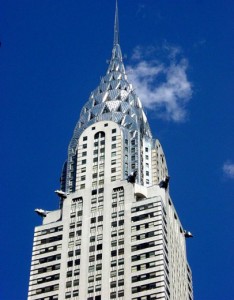
The Chrysler Building in New York City
The Art Deco movement began developing in the 1910s during a transitional period from the Art Nouveau movement. It was in full bloom by the 1920s and 1930s. Art Deco is characterized by stylized designs of people and flowers, as well as geometric designs, and is frequently symmetrical. This is the total opposite of Art Nouveau, where asymmetry is the usual rule. European works of Art Nouveau art trumped American examples, but not necessarily so with the Art Deco movement. There are exceptional examples on both sides of the pond.
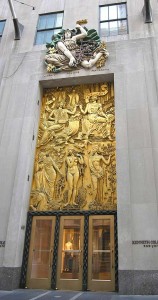
An entrance to Rockefeller Center in New York City by Alfred Auguste Janniot
New York City has some of the finest examples of Art Deco architecture in the world. The Chrysler Building, the Empire State Building and Rockefeller Center are prime examples. In collaboration with famous European artists, the French sculptor, Alfred Auguste Janniot, was employed to create a superb Art Deco, gilded bronze entrance to Rockefeller Center.
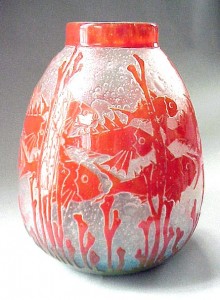
Le Verre Francais Poissons vase
In France, Charles Schneider fully embraced the Art Deco movement and created the finest glass of the period. The designs were stylized and symmetrical. The technique was acid-etching and the vases were signed “Le Verre Francais”. The colors of Art Deco glass are bright and happy as opposed to the mostly true-to-life colors of the Art Nouveau period.
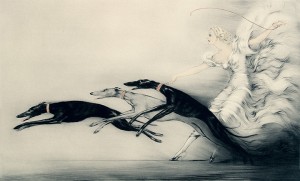
Icart etching 'Speed II', 1933
Louis Icart was most popular during the Art Deco period. His art became more Art Deco as the period became more popular. Here is an example of one of his famous etchings, entitled Speed II, published in 1933. It’s more Art Deco than his original version which was published in 1927 and was very successful. Notice especially the change in the woman’s hairdo.
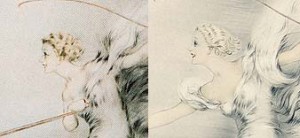
Speed I on the left and Speed II on the right
By the early 1940s, the Art Deco movement had pretty much run its course, but its popularity is very much alive today.
Please send me your suggestions or questions about art glass, lamps, Louis Icart, shows, auctions, etc. If it’s interesting, I’ll answer your question in a future blog entry.
Call or write and let me know what you would like to buy, sell, or trade. philchasen@gmail or 516-922-2090. And please visit my website. chasenantiques.com

Hello,
I have found a couple of prints and I would like your help with identifying their value. I have the Coursing II and Speed II prints. They are framed and backed and appear to be in excellent condition. Is there anything to look for to identify the dates they were printed ?
The date is often found with the copyright information in small print along the top edge on the left or right. There are also several books about Louis Icart that have the information. As far as values, you would need an appraisal. My fee is $125 for the first object and $75 for each additional.